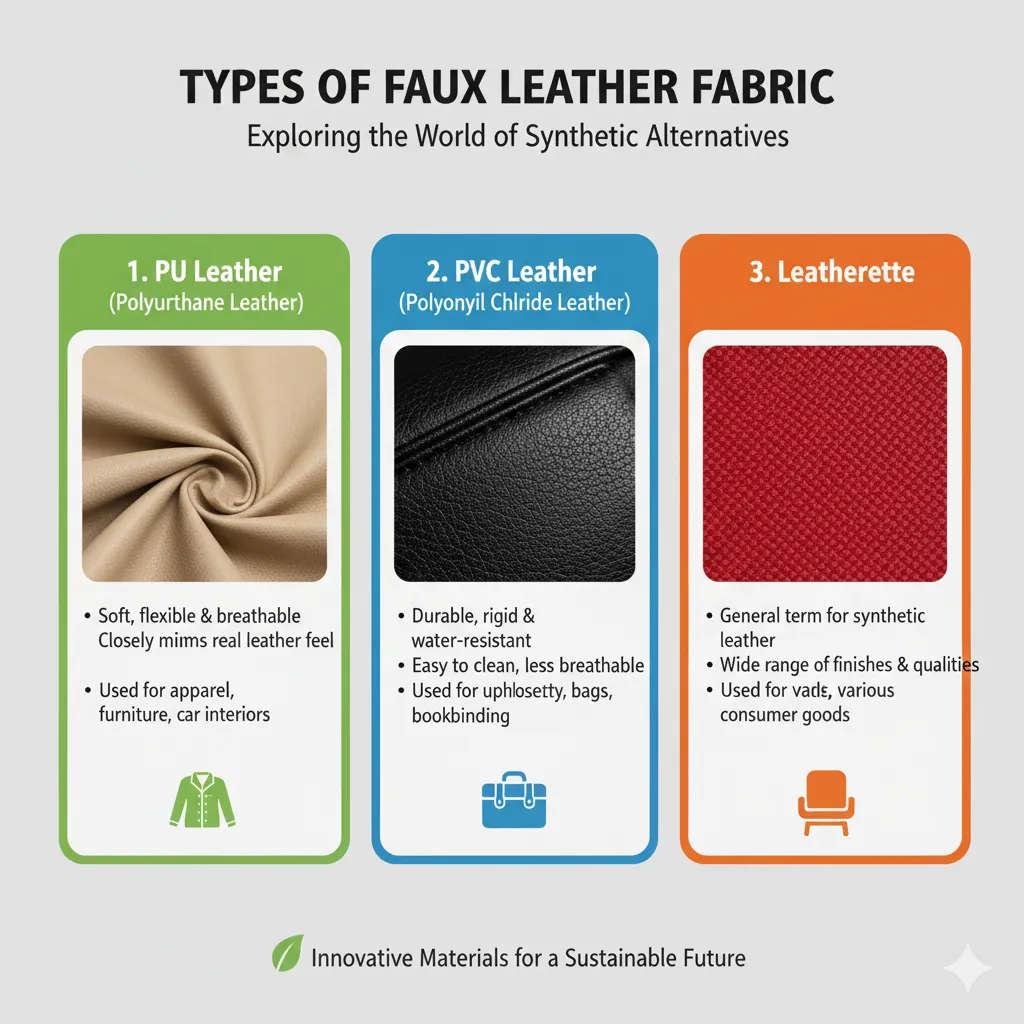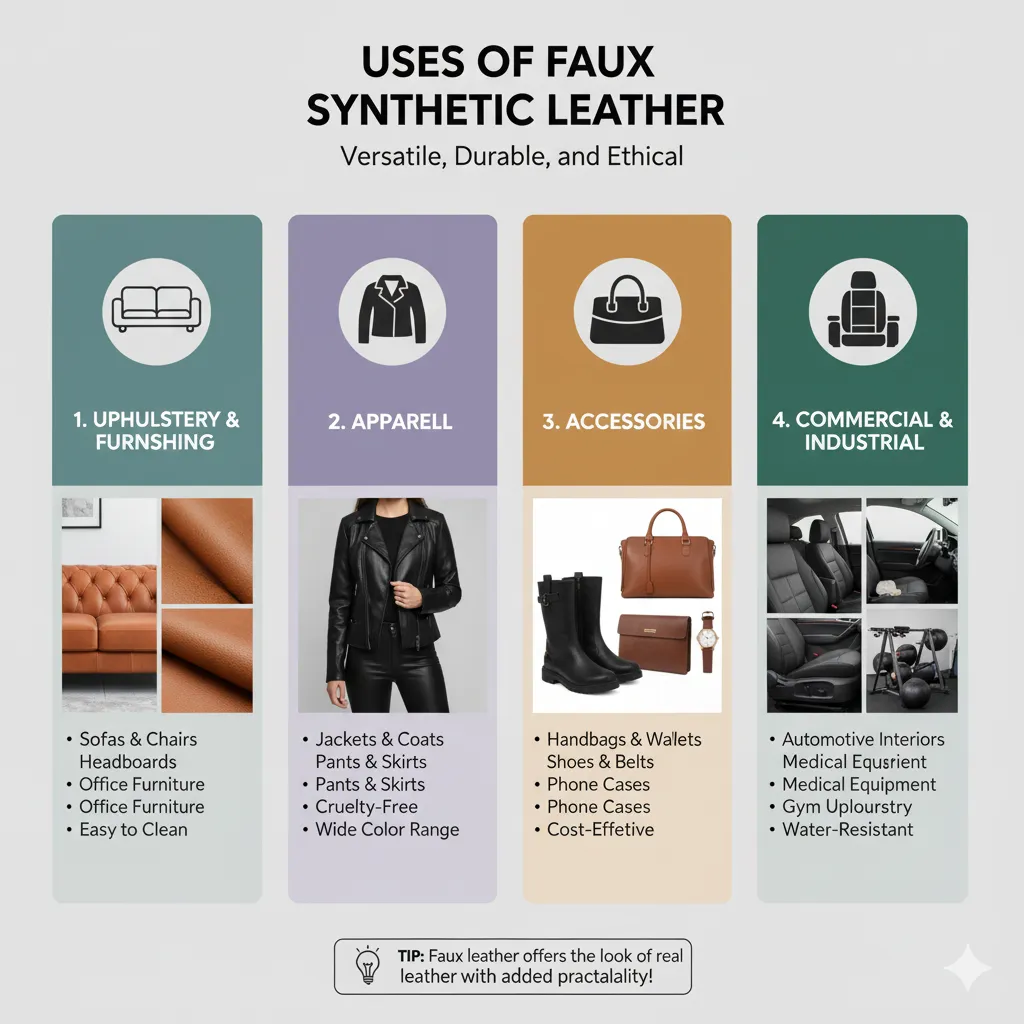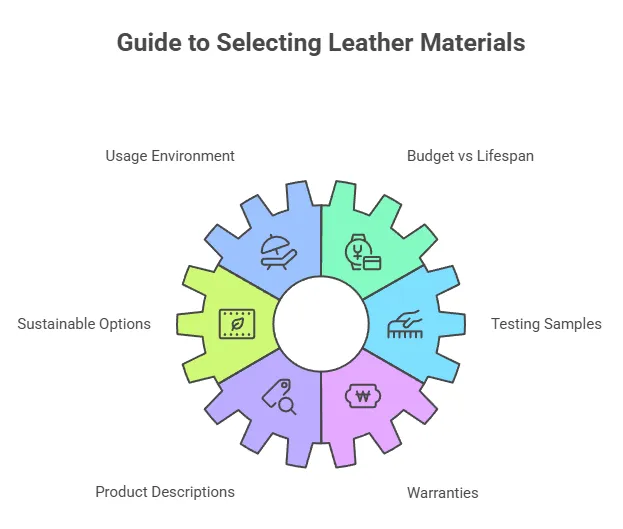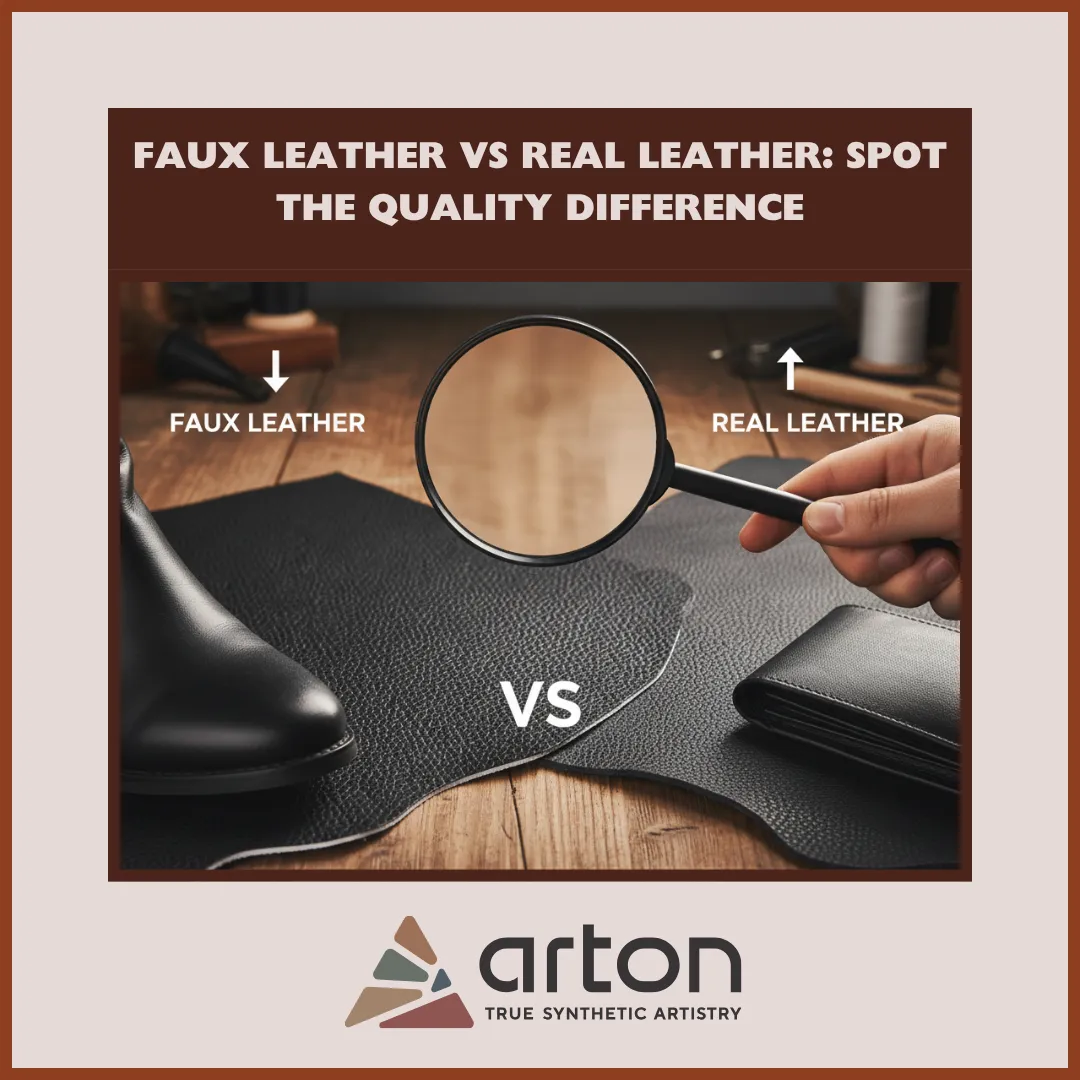09 October, 2025
Introduction to Faux Leather Fabric
Faux leather, also known as synthetic or vegan leather, is a man‑made material meticulously engineered to replicate not only the appearance but much of the tactile feel of genuine leather. It is commonly used by designers, manufacturers, and consumers seeking to enjoy the classic leather aesthetic without using animal hides.
Unlike natural leather, clean faux leather is produced using synthetic compounds like polyurethane (PU) or polyvinyl chloride (PVC leather), sometimes blended with plasticizers and coatings, to provide flexibility, texture, and finish. These synthetic materials are layered over textile bases such as cotton, polyester, or nylon, which act as the structural support.
For individuals seeking cruelty‑free products or a more budget‑friendly alternative to real leather, faux leather offers a compelling solution. It allows fashion brands, furniture makers, and automotive upholsterers to produce leather‑like goods at lower cost, with greater consistency in texture and colour.
Its popularity has surged in industries such as upholstery, fashion, and automotive design due to such advantages. Faux leather can also be easier to clean, maintain, and is often more resistant to staining and water than untreated real leather, making it particularly suitable for everyday items.
Thanks to advancements in material engineering, modern faux leather looks and feels remarkably similar to real leather while offering benefits like increased water resistance, ease of cleaning, and broader customization options in texture, pattern, and color that real leather might not provide so economically.
History and Production of Faux Leather Fabric
The history of faux leather stretches back to the early 20th century, when material scarcity, wartime restrictions, and cost pressures led innovators to explore leather substitutes. Early versions were coarse, less durable, and not always comfortable, but they laid the groundwork for ongoing improvements.
Modern production processes are far more sophisticated and refined. Most faux leathers are created by applying a plastic coating (usually PU or PVC) to a fabric backing. The fabric may be polyester, cotton, or nylon. The plastic layer is often applied in multiple coats to achieve desired thickness, durability, and finish. After coating, the surface is then embossed to resemble real leather grain, giving it a realistic texture that mimics pores, creases, and natural imperfections.
Key steps in production involve:
Synthesizing the plastic materials (PU or PVC), including preparing monomers, plasticizers, and additives like UV stabilizers or softness enhancers.
Creating the textile backing, which must be durable, supportive, flexible, and sometimes breathable.
Applying the coating through processes like extrusion, casting, or spraying, followed by curing (drying, heat treatment).
Texturing and finishing, where the surface is embossed, dyed or pigmented, sealed, and sometimes treated for extra properties like flame retardancy or water repellence.
Faux synthetic leather can be produced in virtually any color or finish, which allows for versatility in application from sleek black jackets, vibrant colour statement bags, metallic faux leathers, to textured furniture panels. Manufacturers can also mimic exotic leathers like reptile skin, crocodile pattern, or ostrich‑look without ethical or cost constraints.
Types of Faux Leather Fabric

Not all faux leather is the same. There are three main types to be aware of, plus variations, each with their unique strengths and weaknesses.
1. PU Leather (Polyurethane Leather)
Soft and flexible, often used in clothing, bags, and car interiors. PU faux leather tends to drape better, feel closer to natural leather, and is lighter in weight.
Offers a more clean look compared to other synthetics: the surface may have fine grain patterns, matte or semi‑gloss finishes, and may even age modestly.
Easier to produce with fewer toxic chemicals than PVC; modern PU processes can use waterborne PU or eco‑PU that reduce volatile organic compounds (VOCs).
May degrade faster than real leather over time under harsh exposure (sun, heat, abrasion). The top coating may peel, crack, or lose colour if not high quality.
2. PVC Leather (Polyvinyl Chloride Leather)
Known for extreme durability and water resistant; PVC leather(polyvinyl chloride pvc) is inherently more waterproof and can resist moisture, making it great for items exposed to water or humidity.
More rigid than PU, making it ideal for furniture and heavy‑duty accessories such as outdoor furniture, marine upholstery, or rugged bags.
Because PVC is chemically tougher, it can sometimes be less forgiving in terms of comfort or touch; it can be stiffer and less breathable.
Contains more plasticizers, which can affect breathability and sustainability. Also may emit more VOCs unless properly stabilized.
3. Leatherette
A broad term referring to fabric‑based faux leather coated with PU or PVC leather; the term often used in popular fashion or home décor items.
Common in clothing and lower‑cost consumer goods, such as shoes, belts, budget jackets, or decorative trims.
Can vary in quality depending on the base fabric, thickness of coating, type of backing, and the finishing process. Good leatherette can approximate texture well; lower quality may look plasticky, feel stiff, or deteriorate quickly.
By comparing examples (e.g. a designer PU jacket vs mass‑market PVC bag), you can see how each type behaves under real‑world use flex, creasing, comfort, ageing.
Key Characteristics of Artificial Leather
Faux synthetic leather is engineered to offer a balance between aesthetics and function. Understanding its characteristics helps consumers make better choices.
Durability
Faux leather resists many of the common wear‑and‑tear issues that plague real leather such as staining, UV fading, water damage. Some high‑quality faux leathers also resist peeling and cracking for years.
Water Resistance
Most synthetic leathers are inherently water repellent, due to their synthetic coatings. Spills often bead up on the surface rather than being absorbed. This makes them ideal for items used outdoors, in humid climates, or with exposure to liquids (e.g. furniture, car interiors).
Stain Resistance and Cleaning
Because the surface is non‑porous (or less porous), faux leather tolerates many stains better: coffee, ink, oils can often be wiped off more easily. Maintenance routines generally involve mild soap, soft cloth, not strong solvents.
Affordability
Compared with full‑grain real leather, faux leather is much cheaper. The cost savings come from cheaper raw materials, easier mass production, consistency of supply, and fewer waste issues.
Versatility
Synthetic leather can be produced in wide‐ranging designs. Think metallic finishes, bright dyes, embossed exotic skins, textured matte or gloss finishes some real leathers cannot be treated so aggressively without damage.
Breathability and Comfort Drawbacks
Synthetic materials typically lack the microscopic pores of real skin/hide, so faux leather can trap heat and moisture. For items worn close to skin (jackets, shoes), this can lead to sweating or discomfort.
Longevity and Ageing
Over time, real leather tends to develop a patina a visual character from wear that many cherish. Faux leather generally lacks this gradual “aging beauty.” Instead, deterioration often shows as cracking, peeling, or loss of top layer, depending on exposure and quality.
Environmental Impact and Considerations
While faux leather presents certain ethical advantages over real leather (no harm to animals), its environmental profile includes both positives and negatives. It’s important to weigh them.
Pros of Faux Leather
Animal‑friendly: No hides required, making it suitable for vegans and animal welfare‑conscious consumers.
Reduced pressure on livestock farming, which contributes to greenhouse gas emissions, land use, and water consumption.
Potential for lower resource use in some cases, depending on scale and technology (e.g., using less water than the tanning industry).
Cons of Faux Leather
Fossil fuel dependencies: PU and PVC are derived from petrochemicals, which come with environmental costs.
Non‑biodegradability: Unless special bio‑based or recyclable synthetics are used, discarded faux leather may remain in landfills a long time.
Chemical pollutants: PVC manufacturing can produce toxic by‑products, plasticizers, dioxins; the production of PU coatings may involve solvents and VOCs.
Faux Leather vs Real Leather: A Comparison
Understanding the strengths and limitations of both real and faux leather helps in choosing what fits your preferences best.
| Feature | Faux Leather | Real Leather |
|---|---|---|
| Price | Much lower initially; mass production reduces cost further | Higher cost due to animal hides, labor, tanning and finishing processes |
| Durability | Good for moderate use; may degrade earlier under harsh or repeated stress | Excellent if properly maintained; can last decades even with heavy use |
| Appearance | Uniform, consistent finishes; may mimic exotic styles; less natural variation | Natural variation, unique markings, patina; each hide is unique |
| Water & Stain Resistance | Very good; easier to clean and often inherently water repellent | Less resistant unless specially treated; can absorb spills, stains |
| Breathability & Comfort | Usually lower; can be hotter, less ventilated near skin | Higher; natural fibers allow moisture vapor flow, more comfortable |
| Environmental / Ethical Impact | No animal use, but issues with plastics & disposal | Animal welfare, but by‑product usage; tanning and energy cost issues |
| Maintenance | Low; wipe clean, occasional conditioner or protector coat | More involved: cleaning, conditioning, protection, avoiding over‑drying |
| Aging Process | May crack, peel, lose colour uniformly | Develops patina, softens, unique character, but needs upkeep |
By comparing these aspects, you can determine which material better suits your lifestyle, climate, and values.
Uses of Faux Synthetic Leather

Faux leather is used across diverse sectors, benefitting from its adaptability, style potential, and cost savings. Here are the most common applications:
Upholstery & Furnishing
Sofas, chairs, couches: Faux PVC leather is easy to clean, appealing for homes with kids or pets.
Car interiors: Seats, door panels, dashboards often use faux leather or vinyl, especially in mid‑range models.
Interior décor: Wall panels, headboards, cushions faux leather allows for dramatic textures and easy maintenance.
Apparel
Jackets, coats, and outerwear: Faux leather allows for stylish cuts, lighter weight, bold colors.
Pants, skirts, dresses: Used sometimes with stretch backing for comfort.
Footwear: Boots, shoes, sneakers use faux leather offers water resistance and style variety.
Accessories
Handbags, wallets, belts: Fashion items where trending colors, designs, and lower cost are key.
Watch straps, laptop sleeves, phone cases: Faux leather offers sleek appearance, sometimes padding and lining.
Decor items: Book covers, trays, decorative boxes.
Commercial & Industrial
Hospitality (hotels, restaurants): Seating, booths, bar stools often use faux leather for ease of cleaning and cost.
Automotive: Interiors of cars, buses, furniture in airplanes.
Outdoor & marine: Faux PVC leather (vinyl) is used in boats, outdoor furniture due to moisture resistance.
Care and Maintenance Tips
To maximize the lifespan and appearance of faux leather products, follow these practical care recommendations.
Routine Cleaning
Wipe with a soft, damp cloth regularly to remove dust and surface dirt.
For mild stains, use warm water mixed with gentle soap (non‑alkaline). Avoid bleach, strong solvents.
Rinse with a clean damp cloth and dry immediately.
Conditioning & Protection
Although synthetic leather does not absorb oils like real leather, conditioners or protectant sprays made for synthetic leathers can help maintain flexibility and reduce cracking.
Apply UV protectant if the item will be exposed to direct sunlight to prevent fading and drying.
Avoiding Damage
Keep away from heat sources, radiators, direct sun; prolonged exposure may dry out the top coating causing cracking.
Avoid sharp objects or rough surfaces that can scratch or puncture the coating.
Storage
Store lying flat or hung to avoid creasing.
Use breathable covers (cotton cloth) rather than plastic, which can trap moisture.
Ensure dry environment; mold and mildew may grow in humid conditions, especially in poor ventilation.
Repair & Restoration
Small scratches: buff lightly with microfiber cloth; some brands offer repair kits.
Peeling or separated edges: sometimes adhesives work, but often irreversible if major.
With proper care, faux leather items can retain good appearance and functionality for many years.
Certifications and Quality Standards
Choosing high‑quality faux leather means looking beyond price; certifications and quality indicators are essential.
What to Look For
Greenguard certification: ensures low chemical emissions; safer for indoor air quality.
LEED: materials with LEED credits often use responsible manufacturing and safer chemicals.
OEKO‑TEX®: tests for harmful substances in textiles and coatings.
International standards: flame retardant ratings, abrasion resistance tests (Martindale cycles etc.), UV resistance.
Brands Known for Quality Faux Leather
Naugahyde®: well known in hospitality, marine, automotive uses; durable, abrasion and stain‑resistant.
Spradling®: produces coated fabrics and vinyls that meet strict performance standards; used for commercial seating, airplanes, etc.
Indicators of Good Faux Leather Quality
Even, high resolution grain or texture; not excessively plastic‑shiny unless purpose is gloss.
Strong, flexible backing fabric; thick enough coating to resist wear.
Solid stitching and edged finishing; no fraying, bubbling or peeling.
Clear labeling: material type (PU, PVC, blend), country of origin, any relevant warranties or certifications.
Choosing the Right Leather Material: Tips & Practical Advice

Selecting the best material depends on how, where, and for how long you plan to use it. Here are practical tips:
Assess usage environment: Outdoor furniture or items in humid climates need stronger water resistance (PVC or marine vinyl). Apparel used in changing weather need flexibility and breathability (PU).
Budget vs lifespan: Decide if you're okay replacing the item in a few years, or prefer an upfront investment that lasts. Sometimes higher‑priced faux synthetic leather with good warranty pays off.
Look for sustainable options: Recycled PU, bio‑based synthetics maybe cost more, but reduce environmental footprint.
Test samples when possible: Feel the material, bend it, check stitching, judge finish under natural light.
Read product descriptions carefully: Terms like “PU coated”, “vinyl”, “leatherette”, “eco‑PU” have different implications. Words like “genuine leatherette” mean synthetic.
Check warranties or guarantees: Knowing what kind of wear the maker covers (peeling, cracking, color fading) helps in choosing reliable products.
Conclusion
Faux leather is a versatile and popular choice also ethical, and affordable alternative to genuine leather. With modern innovations, it’s become a stylish and durable choice for consumers in every sector from fashion and accessories to furniture and automotive interiors.
While it doesn’t always match every strength of real leather especially in terms of breathability and the organic aging process faux leather excels in affordability, variety of finishes, ease of care, and suitability for many practical uses.
The key to making a satisfying choice lies in matching your material to how and where you’ll use it, paying attention to quality, and considering the material’s environmental and ethical footprint. With these considerations in mind, faux leather can offer both form and function for many years



